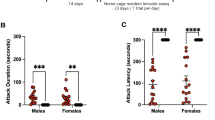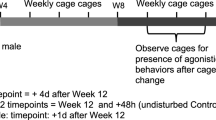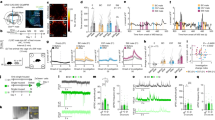Abstract
Rationale
Alcohol consumption is a common antecedent of aggressive behavior. The effects of alcohol on the decision to engage in aggression in preference over pro-social interaction are hypothesized to arise from augmented function within the medial prefrontal cortex (mPFC).
Objective
In a newly developed procedure, we studied social decision-making in male C57BL/6 J mice based on preferentially seeking access to either sociosexual interactions with a female partner or the opportunity to attack an intruder male. While deciding to engage in aggressive vs. sociosexual behavior, corresponding neural activation was assessed via c-Fos immunoreactivity in cortical, amygdaloid and tegmental regions of interest. A further objective was to investigate how self-administered alcohol impacted social choice.
Methods
During repeated confrontations with an intruder male in their home cage, experimental mice engaged in species-specific sequence of pursuit, threat, and attack behavior within < 2 min. Mice were then conditioned to respond at one of two separate illuminated operanda in an experimental chamber (octagon) attached to their home cage; completion of 10 responses (fixed ratio 10; FR10) was reinforced by access to either a female or a male intruder which were presented in the resident’s home cage. Brains were harvested following choice between the concurrently available aggressive and sociosexual options and processed for c-Fos immunoreactivity across 10 brain regions. In two separate groups, mice were trained to rapidly self-administer ethanol prior to a social choice trial in order to examine the effects of alcohol on social choice, sociosexual, aggressive acts and postures, and concurrent c-Fos activity in the mPFC and limbic regions.
Results and discussion
Eight out of 65 mice consistently chose to engage in aggressive behavior in preference to sociosexual contact with a female when each outcome was concurrently available. Self-administered alcohol (experiment 1: 1.2 ± 0.02 g/kg; experiment 2: 0, 1.0, 1.5, and 1.8 g/kg) increased responding for the aggressive option in mice that previously opted predominantly for access to sociosexual interactions with the female. When choosing the aggressive, but not the sociosexual option, the prelimbic area of the mPFC revealed increased c-Fos activity, guiding future detailed inquiry into the neural mechanisms for aggressive choice.








Similar content being viewed by others
References
Akdilek N, Leonard MZ, Kenneally E, Newman EL, Covington HE, Miczek KA (submitted) Stimulation of aggressive arousal by alcohol and suppression by CRF R1 antagonist in C57BL/6J mice: role of central amygdala and ventral tegmental area. Psychopharmacology (Berl)
Bachtell RK, Wang YM, Freeman P, Risinger FO, Ryabinin AE (1999) Alcohol drinking produces brain region-selective changes in expression of inducible transcription factors. Brain Res 847(2):157–165
Been LE, Gibbons AB, Meisel RL (2019) Towards a neurobiology of female aggression. Neuropharmacology 156:107451
Best M, Williams JM, Coccaro EF (2002) Evidence for a dysfunctional prefrontal circuit in patients with an impulsive aggressive disorder. Proc Natl Acad Sci U S A 99(12):8448–8453
Bickel WK, Johnson MW, Koffarnus MN, MacKillop J, Murphy JG (2014) The behavioral economics of substance use disorders: reinforcement pathologies and their repair. Annu Rev Clin Psychol 10:641–677
Brain P (1975) What does individual housing mean to a mouse? Life Sci 16(2):187–200
Chen P, Lou S, Huang ZH, Wang Z, Shan QH, Wang Y, Yang Y, Li X, Gong H, Jin Y, Zhang Z, Zhou JN (2020) Prefrontal cortex corticotropin-releasing factor neurons control behavioral style selection under challenging situations. Neuron 106(2):301-315.e7
Cherek DR, Thompson T, Heistad GT (1973) Responding maintained by the opportunity to attack during an interval food reinforcement schedule. J Exp Anal Behav 19(1):113–123
Covington HE 3rd, Kikusui T, Goodhue J, Nikulina EM, Hammer RP Jr, Miczek KA (2005) Brief social defeat stress: long lasting effects on cocaine taking during a binge and zif268 mRNA expression in the amygdala and prefrontal cortex. Neuropsychopharmacol 30(2):310–321
Covington HE 3rd, Newman EL, Tran S, Walton L, Hayek W, Leonard MZ, DeBold JF, Miczek KA (2018) The urge to fight: persistent escalation by alcohol and role of NMDA receptors in mice. Front Behav Neurosci 12:206
Covington HE, 3rd, Newman EL, Leonard MZ, Miczek KA (2019) Translational models of adaptive and excessive fighting: an emerging role for neural circuits in pathological aggression. F1000Res 8:F1000 Faculty Rev-963
de Almeida RM, Rowlett JK, Cook JM, Yin W, Miczek KA (2004) GABAA/alpha1 receptor agonists and antagonists: effects on species-typical and heightened aggressive behavior after alcohol self-administration in mice. Psychopharmacol 172(3):255–263
Denson TF, Blundell KA, Schofield TP, Schira MM, Kramer UM (2018) The neural correlates of alcohol-related aggression. Cogn Affect Behav Neurosci 18(2):203–215
Everitt BJ (1990) Sexual motivation: a neural and behavioural analysis of the mechanisms underlying appetitive and copulatory responses of male rats. Neurosci Biobehav Rev 14(2):217–232
Falkner AL, Grosenick L, Davidson TJ, Deisseroth K, Lin D (2016) Hypothalamic control of male aggression-seeking behavior. Nat Neurosci 19(4):596–604
Fish EW, De Bold JF, Miczek KA (2002) Aggressive behavior as a reinforcer in mice: activation by allopregnanolone. Psychopharmacol 163(3–4):459–466
Fish EW, DeBold JF, Miczek KA (2005) Escalated aggression as a reward: corticosterone and GABA(A) receptor positive modulators in mice. Psychopharmacol 182(1):116–127
Friedman, NP, Robbins, TW (2022) The role of prefrontal cortex in cognitive control and executive function. Neuropsychopharmacol 47:72–89
Golden SA, Aleyasin H, Heins R, Flanigan M, Heshmati M, Takahashi A, Russo SJ, Shaham Y (2017) Persistent conditioned place preference to aggression experience in adult male sexually-experienced CD-1 mice. Genes Brain Behav 16(1):44–55
Golden SA, Jin M, Heins C, Venniro M, Michaelides M, Shaham Y (2019a) Nucleus accumbens Drd1-expressing neurons control aggression self-administration and aggression seeking in mice. J Neurosci 39(13):2482–2496
Golden SA, Jin M, Shaham Y (2019b) Animal models of (or for) aggression reward, addiction, and relapse: behavior and circuits. J Neurosci 39(21):3996–4008
Goodwin NL, Nilsson SRO, Golden SA (2020) Rage against the machine: advancing the study of aggression ethology via machine learning. Psychopharmacol 237(9):2569–2588
Herrnstein RJ (1970) On the law of effect. J Exp Anal Behav 13(2):243–266
Heyman GM (2013) Addiction and choice: theory and new data. Front Psychiatry 4:31
Hodos W (1961) Progressive ratio as a measure of reward strength. Science 134(3483):943–944
Hodos W, Valenstein ES (1962) An evaluation of response rate as a measure of rewarding intracranial stimulation. J Comp Physiol Psychol 55:80–84
Johanson CE, Schuster CR (1975) A choice procedure for drug reinforcers: cocaine and methylphenidate in the rhesus monkey. J Pharmacol Exp Ther 193(2):676–688
Kollack-Walker S, Newman SW (1995) Mating and agonistic behavior produce different patterns of Fos immunolabeling in the male Syrian hamster brain. Neuroscience 66(3):721–736
Kwiatkowski CC, Akaeze H, Ndlebe I, Goodwin N, Eagle AL, Moon K, Bender AR, Golden SA, Robison AJ (2021) Quantitative standardization of resident mouse behavior for studies of aggression and social defeat. Neuropsychopharmacol 46:1584–1593
Kudryavtseva N. N. (1991) A sensory contact model for the study of aggressive and submissive behavior in male mice. Aggressive Behavior 17(5):285–291
Lau MA, Pihl RO, Peterson JB (1995) Provocation, acute alcohol intoxication, cognitive performance, and aggression. J Abnorm Psychol 104(1):150–155
Meerlo P, Sgoifo A, De Boer SF, Koolhaas JM (1999) Long-lasting consequences of a social conflict in rats: behavior during the interaction predicts subsequent changes in daily rhythms of heart rate, temperature, and activity. Behav Neurosci 113(6):1283–1290
Miczek KA, Barry H 3rd (1977) Effects of alcohol on attack and defensive-submissive reactions in rats. Psychopharmacol 52(3):231–237
Miczek KA, de Almeida RM (2001) Oral drug self-administration in the home cage of mice: alcohol-heightened aggression and inhibition by the 5-HT1B agonist anpirtoline. Psychopharmacology 157(4):421–429
Miczek KA, O’Donnell JM (1978) Intruder-evoked aggression in isolated and nonisolated mice: effects of psychomotor stimulants and L-dopa. Psychopharmacology 57(1):47–55
Miczek KA, Tornatzky W (1996) Ethopharmacology of aggression: impact on autonomic and mesocorticolimbic activity. Ann N Y Acad Sci 794:60–77
Miczek KA, Weerts EM, Tornatzky W, DeBold JF, Vatne TM (1992) Alcohol and “bursts” of aggressive behavior: ethological analysis of individual differences in rats. Psychopharmacology 107(4):551–563
Miczek KA, Weerts EM, Vivian JA, Barros HM (1995) Aggression, anxiety and vocalizations in animals: GABAA and 5-HT anxiolytics. Psychopharmacology 121(1):38–56
Miczek KA, Barros HM, Sakoda L, Weerts EM (1998) Alcohol and heightened aggression in individual mice. Alcohol Clin Exp Res 22(8):1698–1705
Miczek KA, Maxson SC, Fish EW, Faccidomo S (2001) Aggressive behavioral phenotypes in mice. Behav Brain Res 125(1–2):167–181
Miczek KA, Fish EW, De Bold JF (2003) Neurosteroids, GABAA receptors, and escalated aggressive behavior. Horm Behav 44(3):242–257
Miczek KA, de Boer SF, Haller J (2013) Excessive aggression as model of violence: a critical evaluation of current preclinical methods. Psychopharmacology 226(3):445–458
Miczek KA, DeBold JF, Hwa LS, Newman EL, de Almeida RM (2015) Alcohol and violence: neuropeptidergic modulation of monoamine systems. Ann N Y Acad Sci 1349:96–118
Miczek KA, DiLeo A, Newman EL, Akdilek N, Covington HE, III (2021) Neurobiological bases of urges for alcohol consumption after social stress. In: Miczek KA, Sinha R (eds) Neuroscience of Social Stress. Springer Verlag, Heidelberg (in press)
National Research Council (U.S.), Committee for the Update of the Guide for the Care and Use of Laboratory Animals (2011) Guide for the Care and Use of Laboratory Animals, 8th edn. National Academies Press, Washington, D.C.
Neuringer AJ (1967) Effects of reinforcement magnitude on choice and rate of responding. J Exp Anal Behav 10(5):417–424
Newman SW (1999) The medial extended amygdala in male reproductive behavior. A node in the mammalian social behavior network. Ann N Y Acad Sci 877:242–257
Newman EL, Smith KS, Takahashi A, Chu A, Hwa LS, Chen Y, DeBold JF, Rudolph U, Miczek KA (2015) a2-containing GABAA receptors: a requirement for midazolam-escalated aggression and social approach in mice. Psychopharmacol 232(23):4359–4369
Newman EL, Terunuma M, Wang TL, Hewage N, Bicakci MB, Moss SJ, DeBold JF, Miczek KA (2018) A role for prefrontal cortical NMDA receptors in murine alcohol-heightened aggression. Neuropsychopharmacol 43(6):1224–1234
Nikulina EM, Marchand JE, Kream RM, Miczek KA (1998) Behavioral sensitization to cocaine after a brief social stress is accompanied by changes in fos expression in the murine brainstem. Brain Res 810(1–2):200–210
Nikulina EM, Covington HE 3rd, Ganschow L, Hammer RP Jr, Miczek KA (2004) Long-term behavioral and neuronal cross-sensitization to amphetamine induced by repeated brief social defeat stress: Fos in the ventral tegmental area and amygdala. Neuroscience 123(4):857–865
Parmigiani S, Brain PF (1983) Effects of residence, aggressive experience and intruder familiarity on attack shown by male mice. Behav Process 8(1):45–57
Paxinos G, Franklin KBJ (2001) The mouse brain in stereotaxic coordinates, 2nd edn. Academic Press, San Diego
Quirk GJ, Garcia R, Gonzalez-Lima F (2006) Prefrontal mechanisms in extinction of conditioned fear. Biol Psychiatry 60(4):337–343
Roberts AC (2020) Prefrontal regulation of threat-elicited behaviors: a pathway to translation. Annu Rev Psychol 71:357–387
Sandi C, Haller J (2015) Stress and the social brain: behavioural effects and neurobiological mechanisms. Nat Rev Neurosci 16(5):290–304
Scott JP (1966) Agonistic behavior of mice and rats: a review. Am Zool 6(4):683–701
Sgoifo A, Koolhaas J, De Boer S, Musso E, Stilli D, Buwalda B, Meerlo P (1999) Social stress, autonomic neural activation, and cardiac activity in rats. Neurosci Biobehav Rev 23(7):915–923
Stafford D, Branch MN (1998) Effects of step size and break-point criterion on progressive-ratio performance. J Exp Anal Behav 70(2):123–138
Steele CM, Southwick L (1985) Alcohol and social behavior I: the psychology of drunken excess. J Pers Soc Psychol 48(1):18–34
Takahashi A, Kwa C, DeBold JF, Miczek KA (2010) GABAA receptors in the dorsal raphe nucleus of mice: escalation of aggression after alcohol consumption. Psychopharmacology 211(4):467–477
Thompson T (1966) Operant and classically-conditioned aggressive behavior in Siamese fighting fish. Am Zool 6(4):629–641
Valenstein ES, Cox VC, Kakolewski JW (1967) Polydipsia elicited by the synergistic action of a saccharin and glucose solution. Science 157(3788):552–554
Veening JG, Coolen LM, de Jong TR, Joosten HW, de Boer SF, Koolhaas JM, Olivier B (2005) Do similar neural systems subserve aggressive and sexual behaviour in male rats? Insights from c-Fos and pharmacological studies. Eur J Pharmacol 526(1–3):226–239
Venniro M, Shaham Y (2020) An operant social self-administration and choice model in rats. Nat Protoc 15(4):1542–1559
Weerts EM, Tornatzky W, Miczek KA (1993) Prevention of the pro-aggressive effects of alcohol in rats and squirrel monkeys by benzodiazepine receptor antagonists. Psychopharmacol 111(2):144–152
Wilson EO (1975) Sociobiology: the new synthesis. Harvard University Press, Cambridge, MA
Winslow JT, Miczek KA (1985) Social status as determinant of alcohol effects on aggressive behavior in squirrel monkeys (Saimiri sciureus). Psychopharmacol 85(2):167–172
Acknowledgements
The authors would like to thank J. Thomas Sopko, J. Kissel, W. Hsu, M. Perry, K. Hazzard, Chelsea Ty, and Natalie Kane for their assistance. Denis Dupuis and Scott MacCorkle from the machine shop expertly developed and constructed the new octagon apparatus.
Funding
This work was funded by NIH grants AA013983 and DA031734 (KAM, PI).
Author information
Authors and Affiliations
Corresponding author
Ethics declarations
Conflict of interest
The authors declare no competing interests.
Footnote
We dedicate this report to Chris-Ellyn Johanson for her pioneering studies on choice.
Additional information
Publisher's note
Springer Nature remains neutral with regard to jurisdictional claims in published maps and institutional affiliations.
Rights and permissions
Springer Nature or its licensor holds exclusive rights to this article under a publishing agreement with the author(s) or other rightsholder(s); author self-archiving of the accepted manuscript version of this article is solely governed by the terms of such publishing agreement and applicable law.
About this article
Cite this article
Miczek, K.A., Akdilek, N., Ferreira, V.M.M. et al. To fight or not to fight: activation of the mPFC during decision to engage in aggressive behavior after ethanol consumption in a novel murine model. Psychopharmacology 239, 3249–3261 (2022). https://doi.org/10.1007/s00213-022-06208-3
Received:
Accepted:
Published:
Issue Date:
DOI: https://doi.org/10.1007/s00213-022-06208-3




